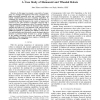Free Online Productivity Tools
i2Speak
i2Symbol
i2OCR
iTex2Img
iWeb2Print
iWeb2Shot
i2Type
iPdf2Split
iPdf2Merge
i2Bopomofo
i2Arabic
i2Style
i2Image
i2PDF
iLatex2Rtf
Sci2ools
102
Voted
IROS
2007
IEEE
2007
IEEE
Cooperation of heterogeneous, autonomous robots: A case study of humanoid and wheeled robots
Abstract— In this paper we present a case study of cooperation of a strongly heterogeneous robot team, composed of a highly articulated humanoid robot and a wheeled robot with largely complementing and some competing capabilities. By combining two strongly heterogeneous robots the diversity of accomplishable tasks increases as the variety of sensors and actuators in the robot systems is extended compared with a team consisting of homogeneous robots. The scenario describes a tightly cooperative task, where the humanoid robot and the wheeled robot follow for a long distance a ball, which is kicked finally by the humanoid robot into a goal. The task can be fulfilled successfully by combining the abilities of both robots. For task distribution and allocation, a newly developed objective function is presented which is based on a proper modeling of the sensing, perception, motion and onboard computing capabilities of the cooperating robots. Aspects of reliability and fault tolerance are ...
Homogeneous Robot | Humanoid Robot | IROS 2007 | Robot | Robotics |
Related Content
| Added | 03 Jun 2010 |
| Updated | 03 Jun 2010 |
| Type | Conference |
| Year | 2007 |
| Where | IROS |
| Authors | Jutta Kiener, Oskar von Stryk |
Comments (0)

